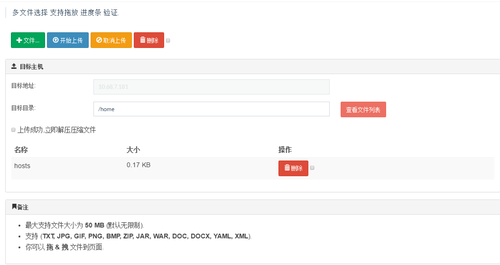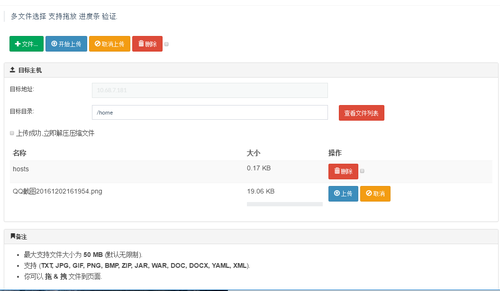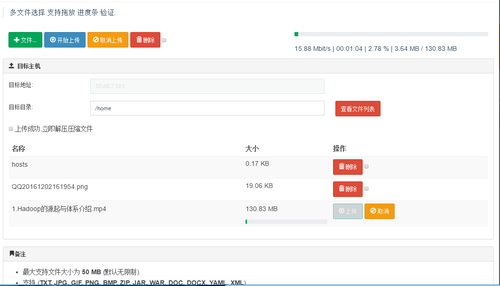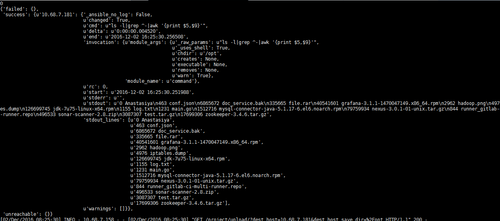首页 > 代码库 > Ansible+Flask+jQueryFileUpload 远程文件管理
Ansible+Flask+jQueryFileUpload 远程文件管理
一.利用Ansible API 2.0对远程主机指定目录内文件的上传,删除,以及解压缩等操作.
核心代码:
AnsibleApi2.py
#!/usr/bin/env python
# -*- coding: utf-8 -*-
#
# this is the Simple Interface package of Ansible2 API
#
# Author: TCollaboration
#
import os
from tempfile import NamedTemporaryFile
from collections import namedtuple
from ansible.parsing.dataloader import DataLoader
from ansible.vars import VariableManager
from ansible.inventory import Inventory
from ansible.playbook.play import Play
from ansible.executor.playbook_executor import PlaybookExecutor
from ansible.executor.task_queue_manager import TaskQueueManager
from ansible.plugins.callback import CallbackBase
class ResultsCollector(CallbackBase):
def __init__(self, *args, **kwargs):
super(ResultsCollector, self).__init__(*args, **kwargs)
self.host_ok = {}
self.host_unreachable = {}
self.host_failed = {}
def v2_runner_on_unreachable(self, result):
self.host_unreachable[result._host.get_name()] = result
def v2_runner_on_ok(self, result, *args, **kwargs):
self.host_ok[result._host.get_name()] = result
def v2_runner_on_failed(self, result, *args, **kwargs):
self.host_failed[result._host.get_name()] = result
class AnsibleTask(object):
def __init__(self, targetHost, passwd=None):
Options = namedtuple(‘Options‘,
[‘listtags‘,
‘listtasks‘,
‘listhosts‘,
‘syntax‘,
‘connection‘,
‘module_path‘,
‘forks‘,
‘remote_user‘,
‘private_key_file‘,
‘ssh_common_args‘,
‘ssh_extra_args‘,
‘sftp_extra_args‘,
‘scp_extra_args‘,
‘become‘,
‘become_method‘,
‘become_user‘,
‘verbosity‘,
‘check‘])
# initialize needed objects
self.variable_manager = VariableManager()
self.options = Options(
listtags=False,
listtasks=False,
listhosts=False,
syntax=False,
connection=‘smart‘,
module_path=‘/usr/lib/python2.7/site-packages/ansible/modules‘,
forks=100,
remote_user=‘root‘,
private_key_file=None,
ssh_common_args=None,
ssh_extra_args=None,
sftp_extra_args=None,
scp_extra_args=None,
become=False,
become_method=None,
become_user=‘root‘,
verbosity=None,
check=False)
if not passwd:
self.passwords = dict(vault_pass=‘secret‘)
else:
self.passwords = {
‘conn_pass‘: ‘{0}‘.format(passwd),
‘become_pass‘: ‘{0}‘.format(passwd)
}
self.loader = DataLoader()
# create inventory and pass to var manager
self.hostsFile = NamedTemporaryFile(delete=False)
self.hostsFile.write(targetHost)
self.hostsFile.close()
self.inventory = Inventory(
loader=self.loader,
variable_manager=self.variable_manager,
host_list=self.hostsFile.name)
self.variable_manager.set_inventory(self.inventory)
self.callback = None
def ansiblePlay(self, module_name, module_args):
# create play with tasks
play_source = dict(
name="Ansible Play",
hosts=‘all‘,
gather_facts=‘no‘,
tasks=[
dict(action=dict(module=module_name, args=module_args))
]
)
play = Play().load(
play_source,
variable_manager=self.variable_manager,
loader=self.loader)
# run it
tqm = None
self.callback = ResultsCollector()
try:
tqm = TaskQueueManager(
inventory=self.inventory,
variable_manager=self.variable_manager,
loader=self.loader,
options=self.options,
passwords=self.passwords,
stdout_callback=‘default‘,
)
tqm._stdout_callback = self.callback
result = tqm.run(play)
finally:
# print result
if tqm is not None:
tqm.cleanup()
os.remove(self.hostsFile.name)
self.inventory.clear_pattern_cache()
return result
def run_playbook(self, playbook_path):
self.callback = ResultsCollector()
pbex = PlaybookExecutor(
playbooks=[playbook_path],
inventory=self.inventory,
variable_manager=self.variable_manager,
loader=self.loader,
options=self.options,
passwords=self.passwords)
pbex._tqm._stdout_callback = self.callback
return pbex.run() # 返回的结果是数字,不同的结果对应不同的数字
def get_result(self):
self.results_raw = {‘success‘: {}, ‘failed‘: {}, ‘unreachable‘: {}}
for host, result in self.callback.host_ok.items():
self.results_raw[‘success‘][host] = result._result
for host, result in self.callback.host_failed.items():
self.results_raw[‘failed‘][host] = result._result[‘msg‘]
for host, result in self.callback.host_unreachable.items():
self.results_raw[‘unreachable‘][host] = result._result[‘msg‘]
return self.results_raw
def ansible_command(targetHost, passwd, module_name, module_args):
"""
ansible 模块接口
:param targetHost 主机ip
:param passwd 主机访问密码
:param module_name 模块名称
:param module_args 模块参数
"""
ansiTask = AnsibleTask(targetHost, passwd)
ret = ansiTask.ansiblePlay(module_name, module_args)
return ret, ansiTask.get_result()
def ansible_playbook(targetHost, passwd, playbook_yaml):
"""
ansible playbook接口
:param targetHost 主机ip
:param passwd 主机访问密码
:param playbook_yaml yaml任务文件
"""
ansiTask = AnsibleTask(targetHost, passwd)
ret = ansiTask.run_playbook(playbook_yaml)
return ret, ansiTask.get_result()二.利用jQueryFileUpload框架完成文件列表,文件上传,文件删除等操作的Http请求,以及UI展示
主要涉及到:
<script src="http://www.mamicode.com/static/plugins/jQueryFileUpload/vendor/jquery.ui.widget.js"></script> <!-- The Templates plugin is included to render the upload/download listings --> <script src="http://www.mamicode.com/static/plugins/jQueryFileUpload/tmpl.min.js"></script> <!-- blueimp Gallery script --> <script src="http://www.mamicode.com/static/plugins/jQueryFileUpload/jquery.blueimp-gallery.min.js"></script> <!-- The Iframe Transport is required for browsers without support for XHR file uploads --> <script src="http://www.mamicode.com/static/plugins/jQueryFileUpload/jquery.iframe-transport.js"></script> <!-- The basic File Upload plugin --> <script src="http://www.mamicode.com/static/plugins/jQueryFileUpload/jquery.fileupload.js"></script> <!-- The File Upload processing plugin --> <script src="http://www.mamicode.com/static/plugins/jQueryFileUpload/jquery.fileupload-process.js"></script> <!-- The File Upload validation plugin --> <script src="http://www.mamicode.com/static/plugins/jQueryFileUpload/jquery.fileupload-validate.js"></script> <!-- The File Upload user interface plugin --> <script src="http://www.mamicode.com/static/plugins/jQueryFileUpload/jquery.fileupload-ui.js"></script> <!-- The main application script --> <script src="http://www.mamicode.com/static/plugins/jQueryFileUpload/bootstrap.min.js"></script>
当然在form表单提交的时候,你可能会带外数据,那么你可能会用到jQueryFileUpload框架中的绑定事件,
如下:
// Callback for the submit event of each file upload:
// submit: function (e, data) {}, // .bind(‘fileuploadsubmit‘, func);
// Callback for the start of each file upload request:
// send: function (e, data) {}, // .bind(‘fileuploadsend‘, func);
// Callback for successful uploads:
// done: function (e, data) {}, // .bind(‘fileuploaddone‘, func);
// Callback for failed (abort or error) uploads:
// fail: function (e, data) {}, // .bind(‘fileuploadfail‘, func);
// Callback for completed (success, abort or error) requests:
// always: function (e, data) {}, // .bind(‘fileuploadalways‘, func);
// Callback for upload progress events:
// progress: function (e, data) {}, // .bind(‘fileuploadprogress‘, func);
// Callback for global upload progress events:
// progressall: function (e, data) {}, // .bind(‘fileuploadprogressall‘, func);
// Callback for uploads start, equivalent to the global ajaxStart event:
// start: function (e) {}, // .bind(‘fileuploadstart‘, func);
// Callback for uploads stop, equivalent to the global ajaxStop event:
// stop: function (e) {}, // .bind(‘fileuploadstop‘, func);
// Callback for change events of the fileInput(s):
// change: function (e, data) {}, // .bind(‘fileuploadchange‘, func);
// Callback for paste events to the pasteZone(s):
// paste: function (e, data) {}, // .bind(‘fileuploadpaste‘, func);
// Callback for drop events of the dropZone(s):
// drop: function (e, data) {}, // .bind(‘fileuploaddrop‘, func);
// Callback for dragover events of the dropZone(s):
// dragover: function (e) {}, // .bind(‘fileuploaddragover‘, func);
// Callback for the start of each chunk upload request:
// chunksend: function (e, data) {}, // .bind(‘fileuploadchunksend‘, func);
// Callback for successful chunk uploads:
// chunkdone: function (e, data) {}, // .bind(‘fileuploadchunkdone‘, func);
// Callback for failed (abort or error) chunk uploads:
// chunkfail: function (e, data) {}, // .bind(‘fileuploadchunkfail‘, func);
// Callback for completed (success, abort or error) chunk upload requests:
// chunkalways: function (e, data) {}, // .bind(‘fileuploadchunkalways‘, func);三.利用Flask搭建Web服务器,Flask依赖两个外部库:Jinja2模板引擎和Werkzeug WSGI工具集。
页面展示:




打印业务数据:


当然这只是目前研究开发的项目中很小的一个功能模块,拿出来分享,谢谢.
本文出自 “TCollaboration” 博客,转载请与作者联系!
Ansible+Flask+jQueryFileUpload 远程文件管理
声明:以上内容来自用户投稿及互联网公开渠道收集整理发布,本网站不拥有所有权,未作人工编辑处理,也不承担相关法律责任,若内容有误或涉及侵权可进行投诉: 投诉/举报 工作人员会在5个工作日内联系你,一经查实,本站将立刻删除涉嫌侵权内容。
